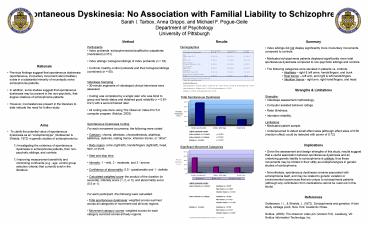Spontaneous Dyskinesia: No Association with Familial Liability to Schizophrenia - PowerPoint PPT Presentation
1 / 1
Title:
Spontaneous Dyskinesia: No Association with Familial Liability to Schizophrenia
Description:
Spontaneous Dyskinesia: No Association with Familial Liability to Schizophrenia ... Category: chorea, athetosis, choreoathetosis, akathisia, ballismus, dystonia, ... – PowerPoint PPT presentation
Number of Views:25
Avg rating:3.0/5.0
Title: Spontaneous Dyskinesia: No Association with Familial Liability to Schizophrenia
1
Spontaneous Dyskinesia No Association with
Familial Liability to Schizophrenia Sarah I.
Tarbox, Anna Grippo, and Michael F. Pogue-Geile
Department of Psychology University of
Pittsburgh
- Method
- Participants
- Index probands schizophrenia/schizoaffective
outpatients (medicated) (n51). - Index siblings biological siblings of index
probands (n 33). - Controls healthy control probands and their
biological siblings (combined) (n 55). - Videotape Sampling
- 30-minute segments of videotaped clinical
interviews were assessed. - Coding was completed by a single rater who was
blind to group and family status and obtained
good reliability (r 0.61-0.91) with a second
trained rater. - All coding was done using The Observer Video-Pro
5.0 computer program (Noldus, 2003). - Spontaneous Dyskinesia Coding
- Summary
- Index siblings did not display significantly
more involuntary movements compared to controls. - Medicated schizophrenia patients displayed
significantly more total spontaneous dyskinesia
compared to non-psychotic siblings and controls. - The following categories were elevated in
patients vs. controls - Akathisia right left arms, hands/fingers,
and trunk - Rest tremor left arm, and right left
hands/fingers - Intention tremor - right arm, right
hand/fingers, and head - Strengths Limitations
- Strengths
- Videotape assessment methodology.
- Computer assisted behavior ratings.
Results Demographics
- Rationale
- Previous findings suggest that spontaneous
dyskinesia (spontaneous, involuntary movement
abnormalities) exists in a substantial minority
of neuroleptic naïve schizophrenia patients. - In addition, some studies suggest that
spontaneous dyskinesia may be present in the
non-psychotic, first-degree relatives of
schizophrenia patients. - However, inconsistencies present in the
literature to date indicate the need for further
study. - Aims
- To clarify the potential value of spontaneous
dyskinesia as an endophenotype (Gottesman
Shields, 1972) in genetic studies of
schizophrenia by - Investigating the existence of spontaneous
dyskinesia in schizophrenia patients, their
non-psychotic siblings, and controls. - Improving measurement sensitivity and minimizing
confounds (e.g., age, control group selection
criteria) that currently exist in the literature.
Significant differences Index probands vs.
Controls age (p 0.004), sex (p 0.001), race
(p 0.035), alcohol/substance (p 0.001) Index
probands vs. Siblings sex (p 0.002),
alcohol/substance (p 0.023) Siblings vs.
Controls alcohol/substance (p 0.010)
Total Spontaneous Dyskinesia
Logistic regression results Index probands vs.
Controls p 0.001 Index probands vs. Siblings
p 0.001 Siblings vs. Controls p 0.227
Significant Movement Categories
Logistic regression results Index Probands vs.
Controls Akathesia p 0.001 Rest tremor
p 0.002 Intention tremor p
0.013 Index Probands vs. Siblings Akathesia p
0.002 Rest tremor p 0.021 Intention
tremor p 0.183 Siblings vs.
Controls Akathesia p 0.259 Rest tremor p
0.012 Intention tremor p 0.057
Significant following Bonferonni correction, p lt
0.007































